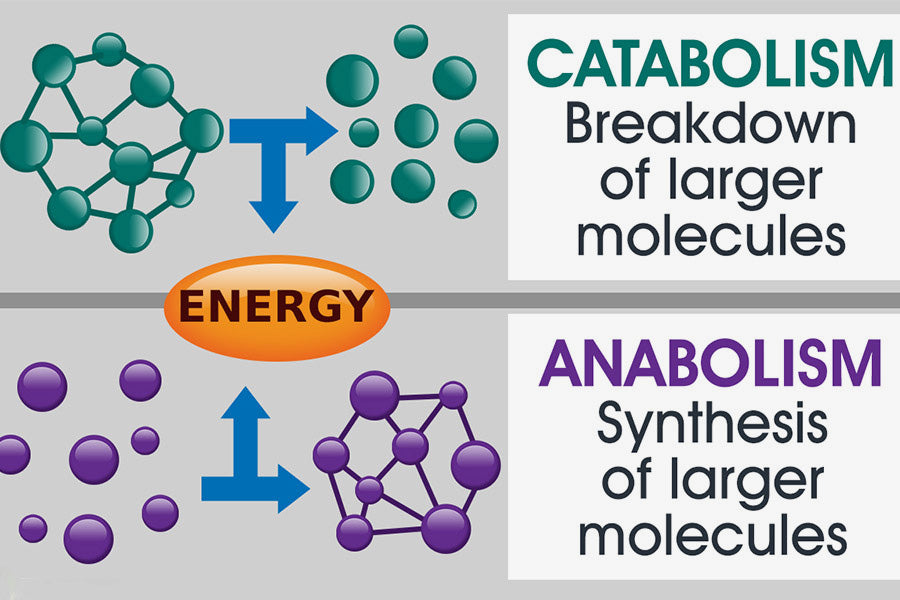Your metabolism consists of a group of processes essential for survival. These mechanisms include both anabolism and catabolism. They both contribute to molecular architecture by releasing and absorbing energy, which is then used to maintain the body's health and functioning. Each metabolic phase occurs simultaneously.
When it comes to molecules, anabolism is all about construction and expansion. This process assembles small, simple molecules into bigger, more complex ones. Anabolism includes gluconeogenesis, bone development, muscle development, and mineralization.
Catabolism is the process by which food molecules are broken down in the digestive tract and metabolized by the body. This process in the body reduces the size and complexity of large molecules. Glycolysis is an example of a catabolic process. Learning the difference between anabolism and catabolism will improve your fat loss and muscle-building workouts.
Anabolism Vs. Catabolism
The table provided below explains the major differences between anabolism and catabolism:
|
Anabolism |
Catabolism |
|
|
Introduction |
Builds complex molecules |
Breaks down complex molecules |
|
Energy |
Requires energy |
Releases energy |
|
Hormones |
Estrogen, testosterone, insulin, growth hormone. |
Adrenaline, cortisol, glucagon, cytokines. |
|
Effects on Exercise |
Typically, anabolic workouts, often anaerobic in nature, increase muscle growth. |
Exercises that promote catabolism tend to be aerobic and effective in burning fat and calories. |
|
Example |
The transformation of amino acids into polypeptides (proteins), glucose into glycogen, and fatty acids into triglycerides. |
The breakdown of macromolecules into their constituent parts includes amino acids from proteins, glucose from carbohydrates, glycogen from sugars, or fatty acids from triglycerides. |
Catabolism Vs. Anabolism - Effects on Body Weight
The metabolic processes of anabolism and catabolism determine whether you put on or lose weight. Remember that when you are in an anabolic state, you continually build and maintain your muscle mass. A catabolic state is one in which bodily mass (muscle and fat) is destroyed or lost.
You may be able to manage your weight if you become more knowledgeable about these pathways and your metabolism in general. Long-term weight loss will result from both anabolic and catabolic mechanisms.
Your chances of losing fat and maintaining or even adding muscle increase with the number of anabolic workouts you do. Because muscle is denser than fat, your weight and BMI may stay the same even if you shed fat.
By breaking down both muscle and fat, catabolic activities, on the other hand, may promote weight reduction. There will be a cost: although you could reduce some weight, you'll also lose a lot of important muscle. You may use the sum of these elements as an equation to predict whether you'll lose or gain weight.
The amount of energy your body needs is determined by subtracting anabolism from catabolism (how much energy your body uses). If your body generates more energy than it requires and stores the excess as fat, you might gain weight. If the output is more than the intake, the opposite can happen.
However, chemical substances called hormones control several metabolic processes in an organism. Hormones are often categorized as either anabolic or catabolic, depending on their influence on the body.
Anabolic Hormones
The following hormones can be categorized as anabolic hormones:
Estrogen:
It is a hormone generated mostly in the ovaries and is present in both men and women. Estrogen controls the menstrual cycle, helps women maintain healthy body weight, and has a function in skeletal development (particularly breast and hip size).
Testosterone:
Testosterone is a masculine hormone that is also found in women. It aids in bone growth, muscular development, maintenance, and the regulation of certain male sexual traits (facial hair, voice).
Insulin:
Insulin, produced in the pancreas, controls how the body processes and uses glucose. Insulin is necessary for the body to convert glucose (found in food) into usable energy. Diabetes develops when the pancreas fails to produce enough insulin or when the body has trouble using the insulin it produces.
Growth Hormone:
Development hormone, secreted by the pituitary gland, promotes and controls growth throughout infancy and childhood. The adult body uses it to control the rate at which bones break down and heal.
Catabolic Hormones
The following hormones can be categorized as catabolic hormones:
Adrenaline:
It is also known as epinephrine and is produced by the adrenal glands. Adrenaline is the primary factor in the "fight or flight" response, which raises blood pressure, quickens the heart rate, widens the airways in the lungs, and fills the body with glucose for instantaneous energy.
Glucagon:
It is produced by the pancreatic alpha cells and promotes the conversion of glycogen to glucose. The liver is responsible for glycogen storage. Glucagon causes the liver to break down glycogen into glucose whenever the body requires additional energy (during strenuous physical activity, intense conflict, or extreme stress).
Cortisol:
Sometimes known as the "stress hormone," it is produced in the adrenal glands. Cortisol is released when there is worry, agitation, or chronic pain in the body. It affects blood pressure, glucose levels, and immune system function inhibition.
Cytokines:
This hormone is a little protein that controls how cells talk to one another. The body continually makes and breaks down cytokines, with the amino acids recycled for use in other systems. The immune system releases cytokines like interleukin and lymphokines in reaction to foreign invaders (bacteria, viruses, fungi, tumors) or damage.
Anabolic and Catabolic Exercises
Anabolic and catabolic exercises are two different types of physical activity that have opposite effects on the body. Anabolic exercises build up muscle tissue, while catabolic exercises break down muscle tissue. The type of exercise that you do will depend on your goals. Let’s look at both.
Anabolic Workouts
Like the anabolic process; anabolic training encompasses a broad spectrum of activities that ultimately result in increased muscle mass.
Anabolic exercises, such as weight lifting and isometrics (resistance), generally increase muscle mass. Aside from aerobic activity, which uses oxygen, all forms of anaerobic exercise are essentially anabolic.
A few examples of anaerobic exercises are sprinting, jumping rope, interval training, and any other activity performed at a very high intensity for very short periods of time. These types of exercise encourage the body to draw from its immediate energy stores and flush out lactic acid from the working muscles.
The body builds up its protein stores, including muscle, bone, and amino acid stores, in preparation for future exertion. The body's fat stores can provide a few of the amino acids it needs.
Related Article: 14 Weeks Full Body HIIT Calorie Destroyer Workout & Meal Plan
Catabolic Workout
Weight loss activities are a part of catabolic training. As a result of this form of training, both fat and muscle tissue are broken down. These concepts are often split in two during training.
Jogging, cycling, swimming, and dancing are examples of catabolic/aerobic workouts, as are any other forms of physical activity that can be maintained for at least 20 minutes at a moderate intensity.
After around 15–20 minutes, the body shifts from utilizing glucose and glycogen to utilizing fat to sustain the body's energy requirements, so time plays a crucial role in achieving effects. Oxygen is essential for the catabolic process.
Related Article: How to Get Started With Hybrid Training for Strength and Endurance
Take Away
Energy is needed for anabolism to grow and build. Catabolism breaks down things using energy. All living things have metabolic processes that interact to perform things like creating energy and repairing cells.
You may be able to achieve your goals in the gym and on the scale by understanding the distinction between anabolic and catabolic processes. Regular cardio and strength training, together with a diet high in nutritious foods, will help you remain healthy inside and out, regardless of your goal.
Reading List
Article Sources
- Campos-Nonato, Ismael, et al. “Effect of a High-Protein Diet versus Standard-Protein Diet on Weight Loss and Biomarkers of Metabolic Syndrome: A Randomized Clinical Trial.” Obesity Facts, vol. 10, no. 3, 2017, pp. 238–51. www.karger.com, https://doi.org/10.1159/000471485.
- Patricia, Justin J., and Amit S. Dhamoon. “Physiology, Digestion.” StatPearls, StatPearls Publishing, 2022. PubMed, http://www.ncbi.nlm.nih.gov/books/NBK544242/.
- Wilcox, Gisela. “Insulin and Insulin Resistance.” Clinical Biochemist Reviews, vol. 26, no. 2, May 2005, pp. 19–39. PubMed Central, https://www.ncbi.nlm.nih.gov/pmc/articles/PMC1204764/.
- Zhang, Jun-Ming, and Jianxiong An. “Cytokines, Inflammation and Pain.” International Anesthesiology Clinics, vol. 45, no. 2, 2007, pp. 27–37. PubMed Central, https://doi.org/10.1097/AIA.0b013e318034194e.











